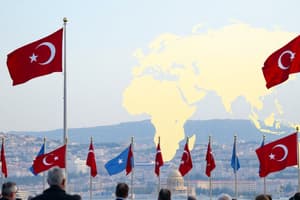Podcast
Questions and Answers
Which of the following countries is NOT a member of the European Union?
Which of the following countries is NOT a member of the European Union?
- Austria
- Spain
- Turkey (correct)
- Finland
As of today, how many recognized candidates are there for membership in the European Union?
As of today, how many recognized candidates are there for membership in the European Union?
- 10
- 7
- 8 (correct)
- 5
Which of the following is NOT one of the EU's three main institutions?
Which of the following is NOT one of the EU's three main institutions?
- European Parliament
- European Council
- European Economic Area (correct)
- European Commission
Who currently holds the position of president of the European Commission?
Who currently holds the position of president of the European Commission?
What is one of the main functions of the European Union?
What is one of the main functions of the European Union?
What is the population of the European Union approximately?
What is the population of the European Union approximately?
Which country was recognized as an EU candidate for membership most recently?
Which country was recognized as an EU candidate for membership most recently?
What does the European Union aim to collectively achieve on a global scale?
What does the European Union aim to collectively achieve on a global scale?
What percentage of the world's population did the EU represent in 2020?
What percentage of the world's population did the EU represent in 2020?
Which city serves as the location for the Central Bank of the EU?
Which city serves as the location for the Central Bank of the EU?
Which of the following is the estimated Gross Domestic Product (GDP) of the EU in 2022?
Which of the following is the estimated Gross Domestic Product (GDP) of the EU in 2022?
Which motto represents the EU's unity in diversity in English?
Which motto represents the EU's unity in diversity in English?
What does 'Ode to Joy' represent for the EU?
What does 'Ode to Joy' represent for the EU?
When were the origins of the EU primarily influenced by the aftermath of which conflict?
When were the origins of the EU primarily influenced by the aftermath of which conflict?
Which of the following statements about the EU's economy is true?
Which of the following statements about the EU's economy is true?
Which city is NOT home to any of the main EU institutions?
Which city is NOT home to any of the main EU institutions?
How many countries are currently members of the European Union?
How many countries are currently members of the European Union?
What is primarily governed by the European Union?
What is primarily governed by the European Union?
What was one reason OPEC+ countries did not increase oil production?
What was one reason OPEC+ countries did not increase oil production?
Which of these companies is part of the 'Seven Sisters' of the oil industry?
Which of these companies is part of the 'Seven Sisters' of the oil industry?
What is Russia's wish regarding oil prices?
What is Russia's wish regarding oil prices?
How often are the lectures in the international organisations course held?
How often are the lectures in the international organisations course held?
What is the purpose of the video 'What are the Universal Human Rights?' in the lesson plan?
What is the purpose of the video 'What are the Universal Human Rights?' in the lesson plan?
What does the acronym IGO stand for in relation to the EU?
What does the acronym IGO stand for in relation to the EU?
What was the primary purpose of the European Economic Community (EEC) established in 1957?
What was the primary purpose of the European Economic Community (EEC) established in 1957?
Which two countries are not part of the Schengen Area despite being EU member states?
Which two countries are not part of the Schengen Area despite being EU member states?
What year was the euro introduced as the official currency?
What year was the euro introduced as the official currency?
What significant crisis did Greece face in the 2010s?
What significant crisis did Greece face in the 2010s?
Which organization was founded in 1951 by the six inner countries?
Which organization was founded in 1951 by the six inner countries?
What event led to the United Kingdom's departure from the EU in 2020?
What event led to the United Kingdom's departure from the EU in 2020?
In the European Commission, which three languages are primarily used for day-to-day work?
In the European Commission, which three languages are primarily used for day-to-day work?
What was one impact of the austerity measures imposed during Greece's debt crisis?
What was one impact of the austerity measures imposed during Greece's debt crisis?
What principle does the EU aim to uphold regarding languages?
What principle does the EU aim to uphold regarding languages?
Which language is primarily used as the working language of the European Court of Justice?
Which language is primarily used as the working language of the European Court of Justice?
Why does the European Union limit its working languages to only three?
Why does the European Union limit its working languages to only three?
Which of the following statements about the languages of the EU is true?
Which of the following statements about the languages of the EU is true?
What was the recommendation made by a Swiss economist regarding EU working languages?
What was the recommendation made by a Swiss economist regarding EU working languages?
What is the implication of the saying 'traduttore, traditore' in the context of translation policies?
What is the implication of the saying 'traduttore, traditore' in the context of translation policies?
What percentage of adults in the EU understand English?
What percentage of adults in the EU understand English?
Which language is considered the most widely used mother tongue in the EU?
Which language is considered the most widely used mother tongue in the EU?
Flashcards
What is the European Union?
What is the European Union?
An international organization of 27 European countries that govern economic, social, and security policies together.
What are the 'Big Oil' or 'Seven Sisters'?
What are the 'Big Oil' or 'Seven Sisters'?
A group of major oil and gas companies that dominated the industry in the mid-20th century.
What is OPEC?
What is OPEC?
The Organization of the Petroleum Exporting Countries (OPEC) is a group of 13 countries that work together to influence global oil prices.
What is OPEC+?
What is OPEC+?
Signup and view all the flashcards
Explain International Governmental Organization (IGO)
Explain International Governmental Organization (IGO)
Signup and view all the flashcards
Why is the EU an IGO?
Why is the EU an IGO?
Signup and view all the flashcards
What is Russia's role in OPEC+?
What is Russia's role in OPEC+?
Signup and view all the flashcards
Why don't OPEC+ countries produce more oil?
Why don't OPEC+ countries produce more oil?
Signup and view all the flashcards
What is the EU's democratic ranking?
What is the EU's democratic ranking?
Signup and view all the flashcards
How many people live in the EU?
How many people live in the EU?
Signup and view all the flashcards
Who controls the EU?
Who controls the EU?
Signup and view all the flashcards
What are the EU's three main institutions?
What are the EU's three main institutions?
Signup and view all the flashcards
Who is the closest equivalent to the EU's leader?
Who is the closest equivalent to the EU's leader?
Signup and view all the flashcards
What is one of the main functions of the EU?
What is one of the main functions of the EU?
Signup and view all the flashcards
What are some other key functions of the EU?
What are some other key functions of the EU?
Signup and view all the flashcards
What are some important principles the EU promotes?
What are some important principles the EU promotes?
Signup and view all the flashcards
What is the EU's population?
What is the EU's population?
Signup and view all the flashcards
What is the EU's economic strength?
What is the EU's economic strength?
Signup and view all the flashcards
What is the EU's motto and anthem?
What is the EU's motto and anthem?
Signup and view all the flashcards
Where are the main EU institutions located?
Where are the main EU institutions located?
Signup and view all the flashcards
What were the beginnings of the EU?
What were the beginnings of the EU?
Signup and view all the flashcards
Why was the EU created?
Why was the EU created?
Signup and view all the flashcards
How is the EU's motto similar to the US's 'Out of Many, One'?
How is the EU's motto similar to the US's 'Out of Many, One'?
Signup and view all the flashcards
Language & Power
Language & Power
Signup and view all the flashcards
Translation Policy
Translation Policy
Signup and view all the flashcards
Institutional Multilingualism
Institutional Multilingualism
Signup and view all the flashcards
Equal Rights for All Languages
Equal Rights for All Languages
Signup and view all the flashcards
Working Languages of the EU
Working Languages of the EU
Signup and view all the flashcards
Lingua Franca
Lingua Franca
Signup and view all the flashcards
De Jure vs. De Facto Languages
De Jure vs. De Facto Languages
Signup and view all the flashcards
Cost of Multilingualism
Cost of Multilingualism
Signup and view all the flashcards
What was the ECSC?
What was the ECSC?
Signup and view all the flashcards
What was the Treaty of Rome?
What was the Treaty of Rome?
Signup and view all the flashcards
What is EurAtom?
What is EurAtom?
Signup and view all the flashcards
When did the EU expand its operations?
When did the EU expand its operations?
Signup and view all the flashcards
What is the Schengen Agreement?
What is the Schengen Agreement?
Signup and view all the flashcards
What is the euro?
What is the euro?
Signup and view all the flashcards
What was the Greek debt crisis and its impact?
What was the Greek debt crisis and its impact?
Signup and view all the flashcards
What was Brexit?
What was Brexit?
Signup and view all the flashcards
Study Notes
International Organizations Course Notes
- Course: International Organisations
- Year: 1, Semester 1
- Subject: Applied Foreign Languages
- Dates: 2024-2025
- Lectures: Five, two-hour lectures every other week
- Topics: United Nations, NATO-BRICS-OPEC, European Union, NGOs, Critical Conclusion
Lecture Plan Details
- Lecture 1: United Nations
- Lecture 2: NATO-BRICS-OPEC
- Lecture 3: European Union
- Homework 1: Video "What Are The Universal Human Rights?" - Benedetta Berti (4'46)
- Homework 2: Text OPEC / OPEC+
- Lecture 4: NGOs
- Lecture 5: Critical Conclusion
Additional Information
- OPEC/OPEC+ Lecture:
- Saudi Arabia and UAE resisting output increases
- Oil production quotas undershot by Nigeria and Angola
- Russia supports low oil prices for good relations
- Oil output increases to be gradual until September
- European Union Lecture:
- 27 member countries
- EU has 7 institutions
- Core EU institutions: European Commission, European Parliament, European Council (each with a different leader)
- EU has 24 official languages. English, French and German are the three main working languages
- EU's goal of promoting linguistic diversity is challenged by the practice of primarily using 3 languages
Studying That Suits You
Use AI to generate personalized quizzes and flashcards to suit your learning preferences.




